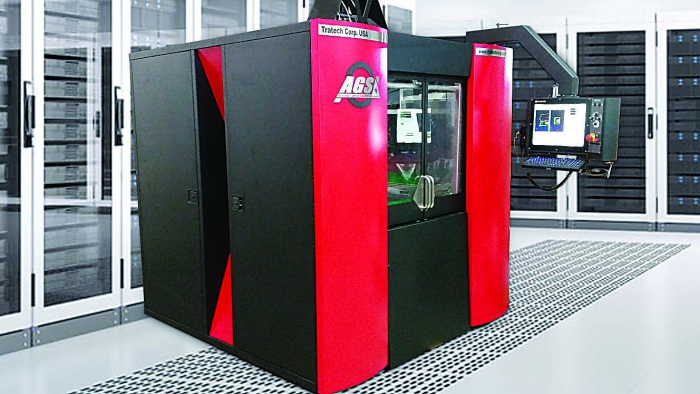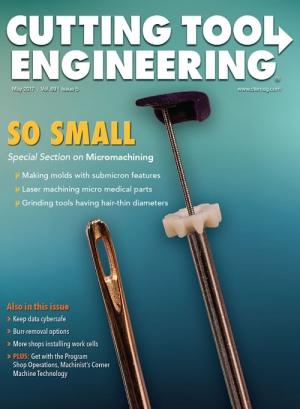An increasing number of parts for multiple industries are being made of strong, heat-resistant, lightweight ceramics. This increase is because the craft of sintering ceramic materials has improved in recent years, allowing parts of appropriate density to be made more cheaply and easily than ever.
Most manufacturers finish their sintered ceramic parts with grinding equipment designed for metals. Tratech Corp., however, has introduced what it says is the first commercially available CNC grinding machine designed specifically for the demanding needs of machining fully sintered ceramics.
Tratech says its Advanced Grinding System (AGS) features an ultrahigh accuracy, 42,000-rpm, through-coolant spindle capable of material-removal rates of 0.06 in.3/min. (1.52 mm3/min.).

The AGS 3-axis CNC machine is designed for grinding fully sintered ceramic parts. Image courtesy of Tratech.
The machine has a 500mm (19.68") × 500mm × 500mm work envelope. A stationary machine bed utilizes an XYZ gantry design to protect the motion control components from abrasive ceramic particles. The bed and motion components are isolated from the machine frame to mitigate environmental impacts on the machining process.
The AGS also features several patent-pending technologies, such as an intelligent process-force-detection system, which automatically stops the grinding process and lifts the wheel out of the workpiece when overload and wheel-failure conditions are detected. In addition, a 16-tool automatic toolchanger features an on-the-fly tool tray system that keeps 256 tools in process storage. Tools and trays can easily be swapped and loaded without interrupting the machining process.
The AGS is capable of grinding very delicate parts that would be unthinkable to grind with any conventional machining process, said Tratech’s head of business development and marketing, Nicole Travert. She said the AGS can produce a 1mm-wide (0.039") wall with a 1:10 width-to-height ratio without any microfractures or surface damage, “leaving a perfectly sharp edge.”
For more information about Tratech Corp., Fort Lauderdale, Fla., visit www.tratechcorp.com or call (844) 408-9252.
Related Glossary Terms
- abrasive
abrasive
Substance used for grinding, honing, lapping, superfinishing and polishing. Examples include garnet, emery, corundum, silicon carbide, cubic boron nitride and diamond in various grit sizes.
- automatic toolchanger
automatic toolchanger
Mechanism typically included in a machining center that, on the appropriate command, removes one cutting tool from the spindle nose and replaces it with another. The changer restores the used tool to the magazine and selects and withdraws the next desired tool from the storage magazine. The changer is controlled by a set of prerecorded/predetermined instructions associated with the part(s) to be produced.
- ceramics
ceramics
Cutting tool materials based on aluminum oxide and silicon nitride. Ceramic tools can withstand higher cutting speeds than cemented carbide tools when machining hardened steels, cast irons and high-temperature alloys.
- computer numerical control ( CNC)
computer numerical control ( CNC)
Microprocessor-based controller dedicated to a machine tool that permits the creation or modification of parts. Programmed numerical control activates the machine’s servos and spindle drives and controls the various machining operations. See DNC, direct numerical control; NC, numerical control.
- grinding
grinding
Machining operation in which material is removed from the workpiece by a powered abrasive wheel, stone, belt, paste, sheet, compound, slurry, etc. Takes various forms: surface grinding (creates flat and/or squared surfaces); cylindrical grinding (for external cylindrical and tapered shapes, fillets, undercuts, etc.); centerless grinding; chamfering; thread and form grinding; tool and cutter grinding; offhand grinding; lapping and polishing (grinding with extremely fine grits to create ultrasmooth surfaces); honing; and disc grinding.
- grinding machine
grinding machine
Powers a grinding wheel or other abrasive tool for the purpose of removing metal and finishing workpieces to close tolerances. Provides smooth, square, parallel and accurate workpiece surfaces. When ultrasmooth surfaces and finishes on the order of microns are required, lapping and honing machines (precision grinders that run abrasives with extremely fine, uniform grits) are used. In its “finishing” role, the grinder is perhaps the most widely used machine tool. Various styles are available: bench and pedestal grinders for sharpening lathe bits and drills; surface grinders for producing square, parallel, smooth and accurate parts; cylindrical and centerless grinders; center-hole grinders; form grinders; facemill and endmill grinders; gear-cutting grinders; jig grinders; abrasive belt (backstand, swing-frame, belt-roll) grinders; tool and cutter grinders for sharpening and resharpening cutting tools; carbide grinders; hand-held die grinders; and abrasive cutoff saws.
- sintering
sintering
Bonding of adjacent surfaces in a mass of particles by molecular or atomic attraction on heating at high temperatures below the melting temperature of any constituent in the material. Sintering strengthens and increases the density of a powder mass and recrystallizes powder metals.
- toolchanger
toolchanger
Carriage or drum attached to a machining center that holds tools until needed; when a tool is needed, the toolchanger inserts the tool into the machine spindle. See automatic toolchanger.
- work envelope
work envelope
Cube, sphere, cylinder or other physical space within which the cutting tool is capable of reaching.


